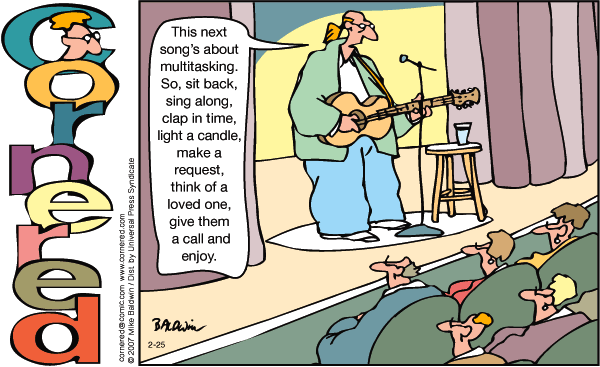
The Myth of Multitasking:
A Researched Reading & Writing Project in Five Phases

English 111 & English Fundmentals, R. Dollieslager
 |
The Myth of Multitasking: A Researched Reading & Writing Project in Five Phases |
 |
Objectives: 1] Reading critically. 2] Connecting reading and writing. 3] Modeling the research and research paper writing process.
This project models the research gathering, note-taking and writing processes in a series of steps or phases and culminates in a short, documented essay.
Designed to be taught/learned in five or six class meetings.
Phase One achieves the following objectives of the VCCS ENF Student Learning Outcomes:
|
Phase One: 1] Reading critically Assignments for the article, “Studies on Multitasking Highlight Value of Self-Control”
1] Vocabulary: Consider important vocabulary and terms from the article which are listed below. For ten minutes freewrite on these words. Write about the words that you are already familiar with and about what you hope to learn in the article about the other terms.
2] While reading, define those vocabulary words on your list as they are meant in the context of the article when you encounter them. Look them up in a dictionary if you are uncertain what they mean from context clues in the article. 3] On a separate note page or Word document, answer the following article analysis questions, after reading, in order to prepare for a) class discussion, b) writing an article summary, and c) using this information in your next essay. Note: Answer the questions in your own words because you will be using those sentences later in a paragraph. If you do this after reading, when the source is closed, there is no risk of plagiarizing. Where you cannot answer the questions from memory, go back to re-read that part of the article. Putting the information in your own words to use in your essay is a research writing skill that is called paraphrasing.
*Diving deeper to understand the original "Marshmallow Test" and its results: read this article, and view this video, recreating the test with kids. How much better are adults able to defer immediate gratification? 4] Summarizing to avoid plagiarism: Use your answers to the questions above when you write a one-paragraph summary (around 200-250 words in length) of this article. Watch this video about how to write a summary. Let's discuss summarizing for researched papers, by following this summarizing process. Homework to be turned in: Vocabulary, answers to reading questions, and one paragraph summarizing the multitasking article. Be sure to keep your comments separate from the summary of the Sparks article by use of a parenthetical citation. Note: I won't formally grade this paragraph or your notes, but I do want to see how you are doing with note-taking and how that is reflected in your summary paragraph. |
Phase Two achieves the following objectives of the VCCS ENF Student Learning Outcomes:
|
Phase Two: 2] Connecting reading and writing
5] Group/class discussion: What have been your experiences when multitasking?
6] Writing in class:
Homework: Two paragraphs above, due at the start of next class. |
Phase Three achieves the following objectives of the VCCS ENF Student Learning Outcomes:
|
Phase Three: 1] Reading critically, 2] Connecting reading and writing Assignments for the article, “Stephen Covey‘s Time Management Matrix Explained"
7] In class: Previewing reading and note taking using the SQ4R reading process. (Since we are taking notes to use in a researched paper, we will add "recite" to the "R's" per Steve Piscitelli's video on SQ4R, which you may review outside of class.) Section your notes sheet into Cornell format and follow the instructions below: (We will all do S and Q together.)
8] Write a summary of the article (about 200 words in length) using your Cornell notes, which are written in your own words if you followed the note-taking instructions, and therefore, they are Homework: Reading notes, summary of the article, and your time management matrix (read more about it below). Note: I will collect your notes and the typed, documented summary of the 4 Quadrants Matrix article and grade them as equivalent to an essay grade. The quality of your notes will be reflected in your grade for this phase of the project. With my feedback and suggestions, once I return the paragraph and your notes, you will revise and edit this graded paragraph to include as body paragraph three in your final essay. Models and templates to help you to manage your time:
|
Phase Four achieves the following objectives of the VCCS ENF Student Learning Outcomes:
|
Phase Four: 1] Reading critically, 3] Modeling the research and research paper writing process
10] Group/class discussion: Are you living and working in Quadrant II?
11] Writing in class:
Phase Five: 3] Modeling the research and research paper writing process
12] In class: Writing about multitasking. Let's do this revising together. Use the following outline for an essay on multitasking, including your two article summaries and the two personal experience paragraphs you wrote. On the draft, we will add the works cited section and cite the summaries to complete the documentation of sources.
Homework: Finish revising the separate paragraphs into an essay, completing the introductory and concluding paragraphs and tying the parts together with good transitions. It is due at the start of the next class. 13] Prepare the Essay for Grading Proofread, listen, edit. In order to proofread and edit your essay successfully do the following:
|
Return to Mr. D's Index page
![]()
![]()
This work is licensed under a Creative Commons Attribution-NonCommercial 3.0 Unported License.